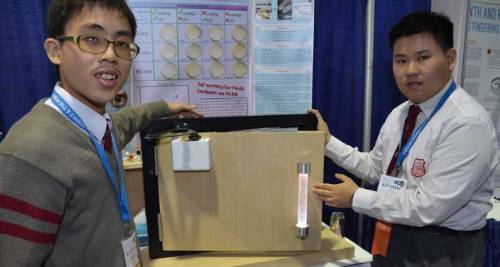#titanium dioxide
Solar Nanowire-Nanotube Purification Filter Offers Easy Access To Clean Drinking Water
Even today, clean water is a privilege for many people across the world. According to the World Health Organization (WHO), at least 1.8 billion people consume water contaminated with feces, and by 2040, a large portion of the world will endure water stress because of insufficient resources of drinking water. Meanwhile, the United Nations Children’s Fund (UNICEF), around 1,800 children die every day from diarrhea because of unsafe water supply, which causes diseases like cholera.
It has become imperative then that we develop efficient and cost-efficient ways to decontaminate water. And that is exactly what a team of scientists led by László Forró at EPFL have accomplished, with a new water purification filter that combines titanium dioxide (TiO2) nanowires and carbon nanotubes powered by nothing but sunlight.
The scientists first show that the TiO2nanowires by themselves can efficiently purify water in the presence of sunlight. But interweaving the nanowires with carbon nanotubes forms a composite material that adds an extra layer of decontamination by pasteurizing the water – killing off human pathogens such as bacteria and large viruses.
Post link
Seeing the invisible: Visible light superlens made from nanobeads
New solid 3-D superlenses extends magnification x5 to reveal new detail
Nanobeads are all around us- and are, some might argue, used too frequently in everything from sun-screen to white paint, but a new ground-breaking application is revealing hidden worlds.
A paper in Science Advances provides proof of a new concept, using new solid 3D superlenses to break through the scale of things previously visible through a microscope.
Illustrating the strength of the new superlens, the scientists describe seeing for the first time, the actual information on the surface of a Blue Ray DVD. That shiny surface is not as smooth as we think. Current microscopes cannot see the grooves containing the data- but now even the data itself is revealed.
Led by Dr Zengbo Wang at Bangor University, UK and Prof Limin Wu at Fudan University, China, the team created minute droplet-like lens structures on the surface to be examined. These act as an additional lens to magnify the surface features previously invisible to a normal lens.
Post link
This door handle kills germs
UV light, powered by the door’s movement, triggers the microbe-killing power of the handle’s coating
BY
PITTSBURGH, Pa. — Diseases spread in many ways. An infected person can cough or sneeze on someone nearby. Or, they can transfer germs through a handshake. But sometimes we pick up germs indirectly. A sick person might leave behind bacteria or viruses when they touch a doorknob, handrail, shopping cart handle or countertop. Anyone else who touches that surface may pick up the microbes. But what if those surfaces could disinfect themselves?
Two teens from Hong Kong asked themselves the same question. Now they’ve developed a door handle that can knock out germs on contact.
The concept is simple. Every time the door is opened, the movement creates power that triggers a germ-killing reaction on the handle. In lab tests, their system killed about 99.8 percent of the germs that they spread onto lab dishes coated with their material.
Research by others has shown that door handles in public areas often host lots of bacteria and viruses, notes 17-year-old Sum Ming (“Simon”) Wong. The tenth grader attends Church of Christ in China Tam Lee Lai Fun Memorial Secondary School in Tuen Mun, China. He and schoolmate Kin Pong (“Michael”) Li, 18, wanted to design a coating for door handles that would be hostile to germs.
After doing some research, they learned that a mineral called titanium dioxide is known to kill bacteria. It’s already used for other purposes in many products, from paints to sunscreens to edible puddings. To make their coating, the teens ground the mineral into a very fine powder.
Titanium dioxide kills bacteria best when lit by ultraviolet (UV) light, says Simon. UV wavelengths are among those in sunlight. But indoor handles and any used at night would have little natural exposure to UV light. So the teens are lighting their door handle from within. Now, every part of the coated handle will see UV light.
To make sure the interior light reaches the coated surface, the teens fashioned their door handle from a long cylinder of clear glass. Each end fits into a bracket. Inside one of the brackets is a strong light-emitting diode (LED). It emits UV light. (Transmitting the light from one end of the handle to the other is similar to the transmission of light through a fiber-optic cable. In this case, though, the glass handle is fat rather than super-thin.)
And here’s the nifty part: The power that makes the UV light shine comes from opening and closing the door. Simon and Michael designed a small gearbox that attaches to the door. Equipment inside the box converts the motion of those gears into electrical power. That power is then carried by wire to the light-emitting diode inside the door handle.
The teens presented details of their research here at the Intel International Science and Engineering Fair. This event was created by the Society for Science and the Public (which also publishes Science News for Students). The annual competition is sponsored by Intel. This year, it brought 1,702 finalists to Pittsburgh in mid-May from more than 70 countries.
The door handle system, Michael and Simon say, might cost no more than about $13 to build.
readmore
I love this!! Love!!
i’m a germaphobe & i need this
Want
Post link




